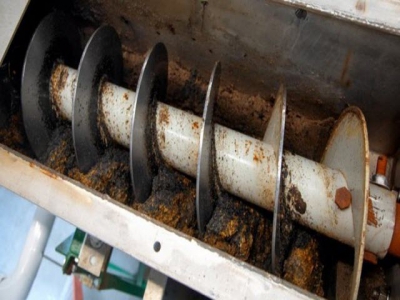Cornell dairy barn implements manure separation system

System cleans sand bedding for reuse, while liquid manure is diverted to anaerobic digester to generate electricity.
Partially clean sand moves through an auger in the sand separator toward the final rinse in the process. Photo: Jason Koski/University Photography.
The Cornell University College of Veterinary Medicine's Teaching Dairy Barn — home to 200 cows — has installed a state-of-the-art system that separates manure from sand bedding material, providing clean bedding for the cows and creating "muck" perfect for making electricity and heat, according to an announcement.
Dairies also use sawdust, woodchips or straw as bedding material, but sand reduces potential bacterial growth while maximizing cow comfort, said Paul Jennette, director of biocontainment operations for the veterinary college.
“For manure management, we have to do something with all of this manure with sand in it,” Jennette said. “Pumping the sand-laden manure into a lagoon or holding tank or onto a truck is difficult, because the sand settles — not to mention, the sand is abrasive on the pumps.”
Manure is conveyed into the new separator adjacent to the barn. Minutes later, clean sand emerges ready for another day’s use; liquid manure is collected in a tank for removal.
According to the university, the system recovers more than 95% of the sand for the teaching dairy to reuse. Instead of importing 30 tons of sand weekly, the dairy now purchases new sand only when needed.
Cornell said this is how the system works: A pump draws sand-laden manure out of the reception pit, dilutes it with recycled water and filters it through a screen that removes bits of hay and other debris. A high-speed pump then pushes the diluted sand and manure through a cyclone that separates most of the manure from the sand. The sand with some residual manure flows into a sand washer, where an auger brings up the sand, which is then sprayed with tap water as a final cleaning step
Captured liquid manure is trucked to the Ithaca Area Wastewater Treatment Facility, where microbial activity breaks down the manure — along with other organic matter — generating methane gas in the facility’s anaerobic digester, according to C.J. Kilgore, chief operator of the facility.
The digester’s methane gas is then used to run microturbines to generate electricity, Cornell said. In turn, the turbines create heat, which is also captured.
“Literally, the manure helps us to run the anaerobic digester and provide power for our facility,” Kilgore said. “We’re creating electricity and extra heat while we’re reducing our electric load.”
“The new separator makes us more self-reliant, and we’re making our dairy operations much more sustainable,” Jennette said.
Có thể bạn quan tâm
 Multidisciplinary approach for dairy cow longevity
Multidisciplinary approach for dairy cow longevity Wageningen University, appropriate management of dairy cows in the peripartum period improves the ability of cows to adapt effectively to lactation
 Fishing by-product boosts cattle intake when added to forage diet
Fishing by-product boosts cattle intake when added to forage diet Supplementing cattle diets with chitosan boosts dry matter intake, digestion and ruminal behavior, say researchers.
 Membrane technology to clean water from dairy manure
Membrane technology to clean water from dairy manure Regenis clean water membrane technology systems to be tested at dairy farm in Washington.